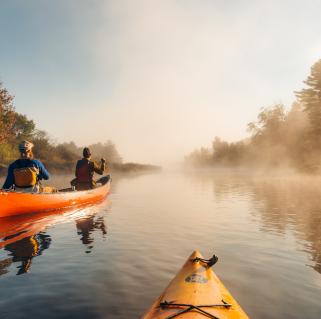Spencer Morrissey
July 08, 2014
Adirondack Paddling
Sizing up the right paddle
When it comes to buying gear for your paddling adventure there are some things that are very important to realize, and special steps that should be taken to get the appropriate gear for your time on the water. Below I would like to share with you a few important steps when purchasing the right equipment more importantly sizing yourself for a paddle. Be sure to check back as I address the selection and sizing of safety gear for
canoeing and kayaking, as well as choosing the appropriate boat for your adventures.Local rental programs
Most outfitters rent canoes, kayaks, and equipment – use them. Try before you buy and many outfitters will use that rental fee toward the purchase of a boat.
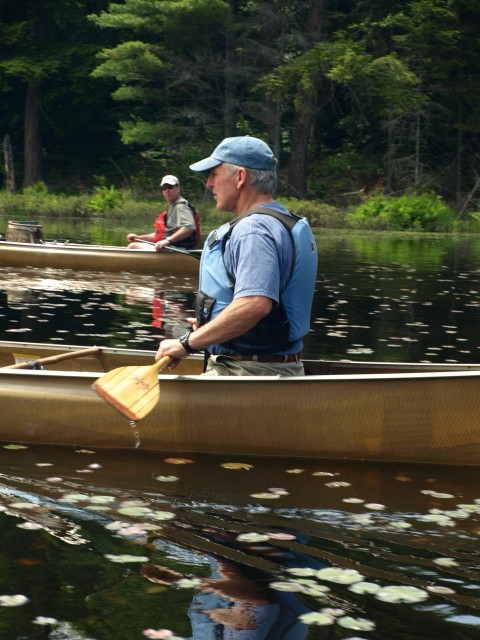
Measuring for a kayak paddle
This is very easy to do. Kayak paddles come in three popular sizes 220, 230, 240. While longer and shorter are available, most outfitters carry fewer of those. Use this graph below to help determine your size.
Paddler Height | Width of your kayak | Under 23" | Most Common 24" to 28" | 29"-33" | Over 30” |
Under 5'5" | 210-220 cm | 220-230 cm | 230-240 cm | 250 cm | |
5'5" - 5'11" | 220 cm | 230 cm | 230-240 cm | 250 cm | |
6'+ | 220-230 cm | 230-240 cm | 240-250 cm | 250-260 cm |
Once you determine the length consider at shaft size. If you have small hands look for a small shaft, most women prefer a smaller diameter.
Then blade design is next. There are three types.
- A wide blade is for high angle paddling and power strokes. The wider and shorter blade give you more power by displacing more water, but it is much more tiring for longer trips.
- A longer and narrower blade is for low angle paddling. This is great for leisurely travel and is much less tiring over long distances.
- There is also an all-purpose blade which is located somewhere in the middle. This blade will work fine for most all types of paddlers and styles.

Weight is a huge factor as well. Aluminum is heavier but sturdier but gets cold during colder conditions. Fiberglass and carbon fiber is much lighter but can get dinged up easily on rocks. A plastic blade with carbon shaft is kind of the best of both-worlds, light weight and a durable blade. .
Do you want the paddle to feather, meaning do you want to change the direction of the blade? Feathering a blade is an option that some use to reduce fatigue on their wrists over long periods of time on the water. Feathering also reduced wind drag on the blade that is out of the water, reducing overall fatigue.
Measuring up for a canoe paddle
This isn’t too bad either, but it often gets overlooked and people just buy whatever feels good in the shop. Follow these steps ahead of time so you know what you need when you get there. As a reminder, all paddles are sold in 2 inch increments, size up. For a wider canoe or a canoe with much higher sides, consider adding 2 inches to the total paddle length to avoid over reaching.
A straight shaft paddle’s measurements are a bit different that a bent-shaft. Start by kneeling down on the floor with your butt about 6" off the floor, mimic the thought of sitting in a canoe. Now take a tape measure and measure from the floor to your nose. This number is the length of the shaft. Add this measurement to the blade length of paddle you are looking at. The combination of these two numbers will give you the length of the paddle recommended for a straight shaft paddle. For a bend-shaft paddle just reduce that number by 2 inches.
If you are already in the store, just kneel as above and place the paddle with the handle on the floor and face straight ahead. The throat (where the shaft and blade come together) should be somewhere between your mouth and the tip of your nose.
Canoe paddle shaft styles, blade shape, materials, weight and such
The best paddles balance weight, strength and flexibility.
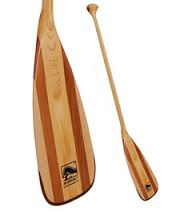
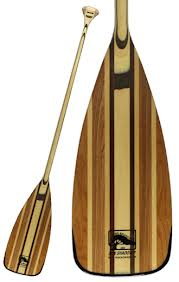
Straight: This traditional style is for all-around paddling but best on rivers, they help with frequent maneuvering and bracing strokes.
Bent: This style is best for flatwater paddling, and maximum efficiency. The blade remains upright in the water at all times and helps with smooth transitions from in to out of the water.
Blade shape: This is easy to determine. A longer blade (beaver tail) is best for flat water. A wider blade is best for rivers. While either one could be used for both, it’s a general rule of thumb.
Materials: Wood is the most common but you will see many plastic or aluminum varieties.
Weight: A lighter paddle equals less fatigue over the course of a long day on the water.
Flexibility: A flexible paddle helps absorb shock with every stroke. Wood tends to be more flexible of a material.
Strength: Most paddles are of durable strength, but a carbon fiver blade is more apt to get damaged for rocks and shores.
A small bit of advice, carry a spare paddle. Paddles do break, be prepared. Even the purchase of a cheap inexpensive spare is better than nothing.
Do you have additional questions about getting the correct paddle, stop by a local gear shop for details or contact me right here and let me see what I can do? Interested in an introduction to canoeing or kayaking – our local guide services will set you up. Ready to buy? We have some outstanding outfitters that are ready to set you up.
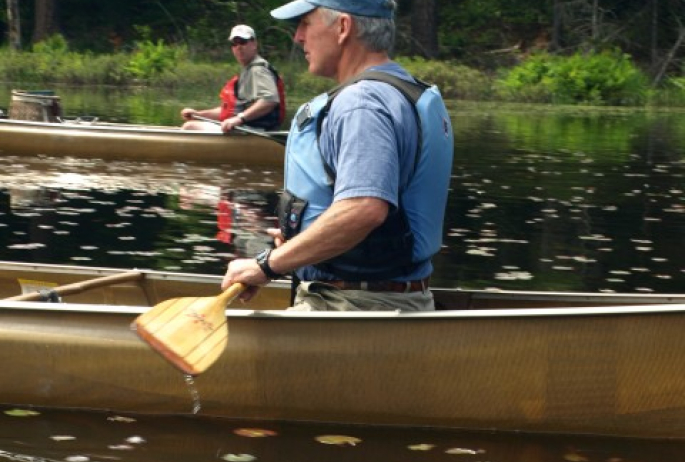

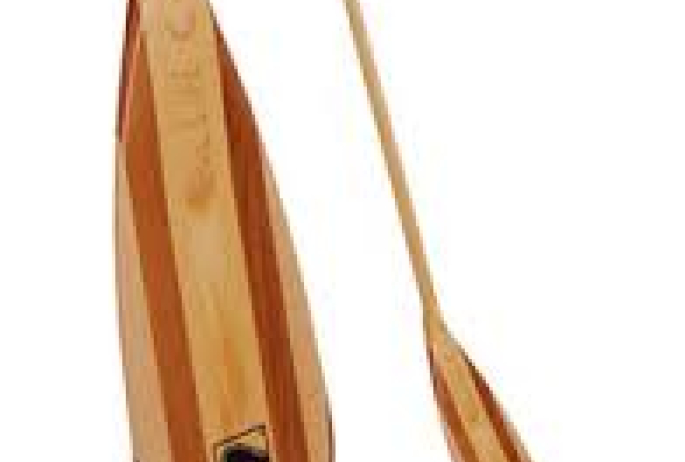

Packages and Promotions
Valid Jan. 21
- Mar. 31
Valid Jan. 21
- Mar. 31
Titus Mountain Ski Package
Voco Saranac Lake
Enjoy your stay at the award winning voco Saranac Lake which includes two adult lift tickets at Titus Mountain Family Ski Center. Additional...
Valid Dec. 1
- Dec. 1
Valid Dec. 1
- Dec. 1
Linger Longer in Saranac Lake
Best Western Saranac Lake
Linger Longer in Saranac Lake at our supremely located property, Best Western Saranac Lake. Stay 2 nights or more and get 15% off!
Valid Jan. 21
- Jan. 21
Valid Jan. 21
- Jan. 21
Pet Getaway
Voco Saranac Lake
Your dog deserves an Adirondack getaway too. Book our pet friendly hotel near Lake Placid welcomes every member of your crew. Book our Pet Package...
Valid Jan. 16
- Mar. 31
Valid Jan. 16
- Mar. 31
Hotel Saranac Ski & Stay Package
Hotel Saranac
Stay & Ski Package Stay at Hotel Saranac and Ski Titus Mountain Day or Night Package Your room reservation includes one adult lift ticket....
Valid May. 1
- Oct. 31
Valid Dec. 6
- Nov. 1
Zip and Whip Expedition
Farmhouse UTVs
Experience Outdoors and Farmhouse UTVs have teamed up to bring your family and friends the Adirondack adventure you've been waiting for....
Valid Jun. 20
- Sep. 7
Valid Mar. 12
- Jun. 30
Guided Nature Immersions - 10% off for Pre-Season Registration
Adirondack Riverwalking & Forest Bathing
Picture it now...you are wading the Ausable River on a warm summer day, feel the cool water against you, hear the sounds of the birds and the...
Valid Jan. 16
- Mar. 31
Valid Jan. 16
- Mar. 31
Hotel Saranac Sled & Spoke Package
Hotel Saranac
Snowmobile Package Hotel Saranac and Sara-Placid Sled & Spoke have partnered so you and a guest can explore dozens of miles of ADK snowmobile...
Valid Jan. 21
- Jan. 21
Valid Jan. 21
- Jan. 21
Stay and Dine
Voco Saranac Lake
Receive a 50 dollar credit per stay to use in our Boathouse Saranac Lake Pub. Enjoy an exceptional dining experience with unparalleled views great...

